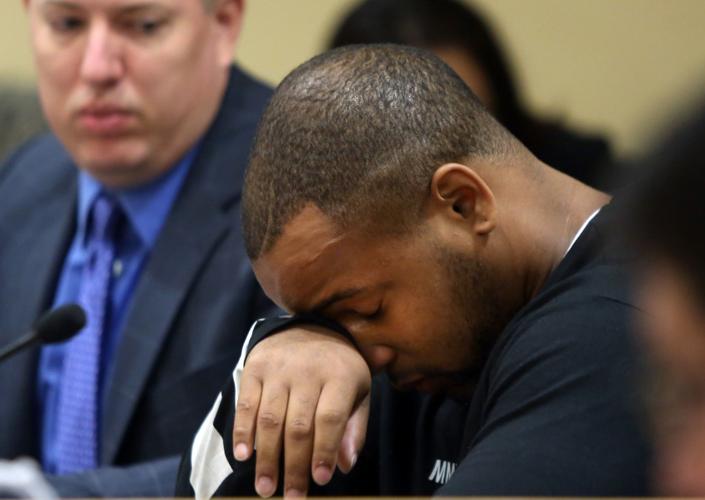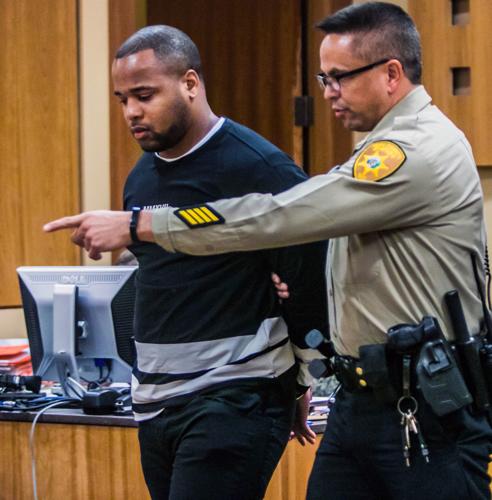Most of Tucson was still reeling from the FBI investigation into assistant basketball coach Book Richardson when a second University of Arizona athletic department scandal quietly made its way into federal court.
A woman who accused former Arizona Wildcats running back Orlando Bradford of domestic violence last year has filed a lawsuit against the UA, saying school officials knew for months before her attack that he posed a danger to women but failed to take action. The suit alleges a violation of her civil rights, intentional infliction of emotional distress and negligence by the university.
The university must adhere to Title IX, a federal law that protects students from gender discrimination. It includes protections against sexual assault and relationship violence.
Since 2015, two other UA student-athletes have been accused of rape, and a former assistant track and field coach is awaiting trial for assaulting and threatening a student-athlete. The coach’s legal bills — nearing half a million dollars — are being paid by taxpayers.
And two weeks ago, a current member of the UA football team was arrested on a charge of domestic violence assault.
The incidents point to a sliding scale within the athletic department, the lawsuit says, where rules vary depending on how talented the player or coach is.
“The actual de facto policy of the U of A athletic department was to try to minimize reporting of acts of domestic violence, to minimize adverse consequences of such acts, and to prevent such acts from becoming public knowledge, at least for valuable players,” the lawsuit says. The Star does not generally name alleged victims of domestic abuse or sexual assault.
The Star contacted UA president Robert C. Robbins, the school’s Title IX coordinator, and several members of the athletic department for comment. UA spokesman Chris Sigurdson responded on behalf of all of them Friday afternoon with a seven-paragraph statement that included links to online resources offered by the school and a September memo from Robbins.
The statement emphasized that the UA’s procedures are “student-centered,” meaning the accuser always chooses how to proceed.
“Faculty and staff are required to make sure any allegations are reported to Title IX or Dean of Students, but it’s up to the student to decide how far they would like the university to go and what actions we can take,” the statement said.
The policy is different from that of law enforcement, which is required to pursue an investigation once an accuser files a report.
Actions by the UA can range from making sure that students don’t have similar class schedules to a student code of conduct inquiry, or even filing criminal charges, the UA’s statement said.
The UA offers online and in-person training “to help prevent and respond to the harmful effects of sexual assault, sexual harassment and gender violence,” the statement said, adding that the school also has additional programs departments can request from human resources and student affairs.
Over the past few years, the UA has increased Title IX prevention and education efforts, he wrote. Despite that, reports to university police of sexual assault, domestic violence and dating violence rose from 2015 to 2016.
“The UA has been very clear about our commitment to end sexual violence, including relationship violence,” the statement said. “We have publicized the number of reports we received for the previous years and the resources in place for student support.”
Details of the lawsuit and other recent allegations of domestic and sex-related crimes were pieced together by the Star’s examination of records from Pima County Superior Court, U.S. District Court of Arizona, Tucson Police Department, University of Arizona Police Department, Pima County Consolidated Justice Court and Maricopa County Superior Court.
Between April and September 2016, three women came forward to police to report abuse by Bradford. Each woman said separately that she had been choked by him on more than one occasion.
Bradford was arrested on Sept. 14, 2016, after one of the women told police that she’d been assaulted over two days after she and Bradford fought about a scratch on his car, her reluctance to eat a Frosty he’d purchased and Bradford’s suspicions that she was texting with another man, Tucson police reports show.
She told police Bradford choked and slapped her repeatedly and punched her in the face. At one point, according to a police report, Bradford choked the woman while telling her, “Say goodbye to your mom.”
The woman told authorities she stayed two nights with Bradford out of fear, and that when he left for football practice in the morning, she called her mother, who called Tucson police, the report says.
When detectives interviewed her they noted marks on her neck, arms, ribs, stomach and head, the report says.
The next day, a second woman came forward to say that Bradford had also assaulted her on multiple occasions beginning in January 2016. He was re-booked into the Pima County jail on new charges.
Bradford was ultimately charged with 10 felonies and five misdemeanors in connection with the incidents. He later pleaded guilty to two felony counts of aggravated assault domestic violence and is to be sentenced Nov. 20.
In February, the second woman who reported Bradford to police filed a $1 million claim against the UA and Arizona Board of Regents, saying the school had prior knowledge of Bradford’s violent behavior and failed to take appropriate action to stop him.
While that claim has not been settled, it has also not yet been pursued in court, according to the woman’s attorney, Kimberly Hult.
The federal lawsuit filed earlier this month follows a $1 million claim filed in August by the first woman who reported Bradford to police. When suing a government entity or state agency, a claim precedes a formal lawsuit.
Because Title IX is a federal law, the lawsuit was moved from Maricopa County Superior Court to federal court, documents show.
The lawsuit says that, in July, the plaintiff learned of a third woman who had alleged violence by Bradford. That woman had reported Bradford’s alleged abuse to several members of the UA athletic staff, the suit says. Her allegations came months before Bradford’s September arrest.
The UA athletic department was made aware of the accusations against Bradford as early as December 2015, when the mother of his then-girlfriend called the department to say Bradford had physically attacked her daughter, the lawsuit says.
That woman told police that she and Bradford began dating in the fall of 2015 and ended their relationship in April 2016, a Tucson police report says.
The woman, who was also a UA student-athlete, told police Bradford assaulted her three or four times. He choked her at least twice, she told TPD.
When the woman went home for Christmas break, she told her aunt that she and Bradford broke up because he was abusive. The woman’s aunt told her mother, who said she called her daughter’s softball coach, Mike Candrea, to tell him about the situation, the police report says.
The former girlfriend later told police that, when she returned to school in January 2016, she spoke with Candrea, who told her to not have any contact with Bradford, the TPD report says.
In April 2016, the same woman called campus police to report that Bradford had been harassing her although their relationship was over. She said he had spent nearly two hours outside her dorm room the previous night, according to a UA police report. When officers went to the dorm to interview her, she was with a UA senior athletic director, whose name was redacted from the UAPD report.
The woman told UA police officers that she had called them because she was afraid of Bradford. She said that in March, she’d reported the relationship to the Dean of Students and notified members of the athletic staff, the UAPD report says.
The woman “expressed to the Dean of Students at the U of A and additional members of the athletic department at the time her continued fear of Bradford and difficulties avoiding contact with him given their mutual school-related activities,” the lawsuit says.
The Pima County Attorney’s Office declined to prosecute Bradford in connection with the incident at the woman’s dorm room, but the UA put a “no contact order” in place, the UAPD report shows. Bradford was banned from living in the on-campus dorms, according to the lawsuit.
The UA arranged off-campus housing for Bradford, putting him in a home with other members of the football team, the lawsuit says.
School officials were “aware that the off-campus housing ‘solution’ would involve even less supervision of Bradford and therefore even more risk of harm to (the victim) or other female students,” the lawsuit says.
Within a few months, Bradford became involved with the two women who reported him to Tucson police in September.
After Bradford’s September arrest and dismissal from the football team, coach Rich Rodriguez said that he has a “zero tolerance” policy when it comes to domestic violence committed by athletes on or off campus, and that a single incident would result in a player being removed from the team.
The plaintiff “heard in the media that coach Rich Rodriguez had a ‘one-strike and you’re out’ domestic violence policy for his players,” the preliminary claim says. “Unfortunately, based on the new information we received last month, it appears that (she) was mistaken, and the true policy was ‘one strike that goes public and you’re out.’”
Bradford admitted to a witness that he “tortured” the plaintiff, the lawsuit says. One of his teammates reported that he was joking about the incident in the locker room, the lawsuit says.
“The acts and omissions of (the UA) in response to Bradford’s prior acts of domestic violence were completely unreasonable under the circumstances,” the suit says. It adds that, by failing to take action, the UA “allowed Bradford to retain his favored position within the campus community without consequence for his known propensity for domestic violence and with reckless disregard for the safety of female students.”
Under Title IX, the UA was required to investigate the first victim’s report against Bradford regardless of whether criminal charges were filed. If it did, the results weren’t made public. It’s unclear if Bradford was disciplined in connection with the woman’s claims.
“This situation certainly raises a lot of concerns,” said Alexandra Tracy-Ramirez, an attorney who used to work for the UA as a Title IX investigator. “I would have a lot of questions about what was happening, who knew what and when they knew it and what they did with that information.”
The December 2015 conversation between Bradford’s then-girlfriend and Candrea “was a critical moment” during which Candrea could have spoken to the woman about filing a formal complaint and her options for on-campus support, Tracy-Ramirez said.
“If responsible employees within the university knew or had reason to know that harassment or abuse was happening, and they didn’t get that information to appropriate administrators, I think there’s something to be said for alleging the university could have done something differently,” she said.
The Star contacted Candrea for comment. His response was the general statement from the university.
Also concerning is what the UA knew and how officials decided the first woman’s allegations against Bradford were substantial enough that he had to be moved off campus, Tracy-Ramirez said.
“Moving someone around, ‘no contact orders’ and changing housing locations … are all steps that an institution can take before finding that someone had done something wrong. They’re considered interim safety steps,” she said. It’s unclear in this case if these were interim steps or sanctions, or if there was an investigation into Bradford’s behavior.





